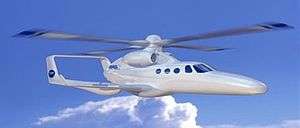GBA-DARPA Heliplane
| Heliplane | |
|---|---|
 | |
| Image of baseline GBA-DARPA Heliplane concept, showing its free-spinning rotor, which is fitted with integral tipjets, fed with bypass air from two Williams gas-turbine propulsion engines | |
| Role | Experimental helicopter |
| National origin | United States |
| Manufacturer | GBA-DARPA |
| Status | Cancelled |
The GBA-DARPA Heliplane was a proof-of-concept, long-range, VTOL aircraft intended to cruise at twice the speed of conventional helicopters.[1] It was funded by the Defense Advanced Research Projects Agency (DARPA) and designed by Groen Brothers Aviation (GBA), which has since been re-branded as Skyworks Global.
DARPA's objective was to achieve performance with a rotary-wing aircraft comparable to that of a fixed-wing plane. The concept combined technical aspects of a gyroplane, which GBA had been working on since the late 1980s,[2] with a fixed-wing business jet.
The work was part of a potential multi-year, US$40-million, four-phase program. GBA, along with Georgia Tech, Adams Aircraft Industries, and Williams International, worked on Phase 1 of that program, a 15-month effort funded at $6.4 million. Phase 1B of the program was managed by Georgia Tech, using GBA as a subcontractor. Phase 2 development was to include a "subscale wind tunnel demonstration in the high-speed, high-altitude wind tunnel at NASA Langley and the building of a full-scale tipjet nozzle. Phase 2 [was] anticipated to be a substantially bigger undertaking (valued at $24-28 million)."[1]
Due to issues with noise generated by the tipjets, the program was terminated by DARPA in 2008.[3]
References
- 1 2 Pengeley, R. (June 2009). "Gyrodyne Testing Resumes in the US". Jane's International Defence Review. p. 13.
- ↑ "Best Inventions of 2001: Gyroplane". Time. 19 November 2001.
- ↑ "Darpa Takes Another Shot At High-Speed VTOL". Aerospace Daily & Defense Report. Aviation Week. 26 February 2013. Retrieved 31 July 2018.